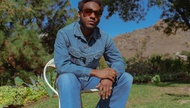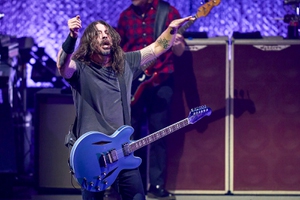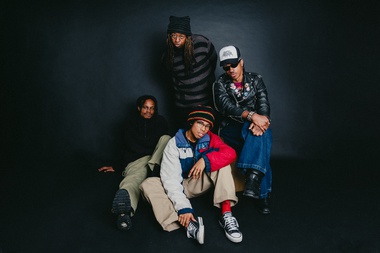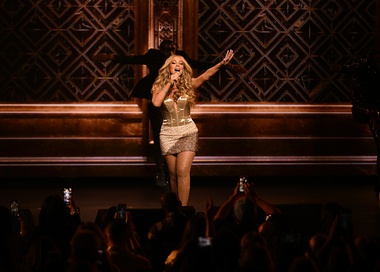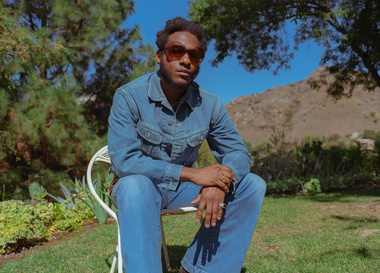Among pop obsessives, fewer bands are more revered than British duo Tears for Fears. Perhaps that’s because the band—co-vocalists/instrumentalists Roland Orzabal and Curt Smith—creates music that’s both accessible and challenging, from the introspective, morose synth-pop of 1983’s The Hurting and the booming electronic-pop of 1985’s blockbuster Songs From the Big Chair to 1989’s Beatles-esque The Seeds of Love. Timeless songwriting helps, too; in fact, the band is now influencing a whole new generation of musicians. Lorde recently covered “Everybody Wants to Rule the World” for The Hunger Games: Catching Fire soundtrack.
Calling from an LA studio—where he and Smith are working on music for a long-awaited new album, their first since 2004’s Everybody Loves a Happy Ending—Orzabal reflected on the recent deluxe edition of Songs From the Big Chair, about writing his first novel and where Tears for Fears is headed next. He also called the Lorde cover “fantastic.”
You guys recently released a massive reissue of Songs From the Big Chair. It’s impressive that there were so many alternate versions, remixes for an eight-song album. Was that a function of the era, or is it more that as a musician, you approach your songs as permanent works in progress? In those days, because we were releasing everything on vinyl, you’d release a 7-inch single, but there would always be a 12-inch remix, which had to be longer. So that’s why we ended up with so many different versions. And then there’s live versions and the Scenes From the Big Chair [documentary]. And on the new deluxe edition, there’s all the 5.1 remixes, which it puts it into another realm.
Listening to the remastered version of the album, there were so many sounds popping out I that had never heard there before. I think a lot of people are surprised even still by the sound quality of it all. But we did spend a long time [on it], and that’s something we cared about greatly. And all these years later, I’m very glad we did.
What did you like most about Steven Wilson’s 5.1 remixing job? He did an amazing job with the recent XTC reissue, too. First of all, he had to track down all the tapes, which should be easy but wasn’t. They were scattered all over the world. He tracked down about 99.5 percent of them, but there were still some things he actually had to nick off the record. That was a lengthy process. Before he could do the 5.1, he had to re-create all the mixes. He did an extremely good job sending me stuff, songs that I hadn’t heard for 20 years, because I hadn’t bothered to listen to them, things like “The Working Hour.” I’m thinking, “Wow, that’s pretty damn good” (laughs). Confronted with your 23-year-old self writing the most incredibly emotional songs—it was an interesting experience.
What was your reaction hearing those songs now with the benefit of hindsight? Obviously, the big hits like “Shout,” “Everybody Wants to Rule the World,” “Head Over Heels,” we play live, so there’s nothing new about them to me. But it was the other things, like “I Believe” and “The Working Hour” and “Listen,” which I was pleasantly surprised with.
You guys recently reworked “The Working Hour” live. Was that because of the reissue? Partly, and partly because we want to do some fresh stuff—even though it’s an old song—just for the audience. We put it as an encore, just in case it went horribly wrong, but it turned out to be absolutely fantastic, and it went down very well. It’s a shame we can’t do it every show, really, but we’d need an extra man.
What else goes into deciding what songs from your back catalog you want to work up from tour to tour? It’s just simply the best songs live. A lot of it’s to do with rhythm. All of the up singles—”Mad World,” “Pale Shelter,” “Sowing the Seeds of Love”—they’re very easy to do. But we also like to include some of the more elaborate and intricate songs, “Badman’s Song,” from the Seeds of Lovealbum, that’s a great song to play live.
I was interested to read in the Songs From the Big Chair reissue liner notes that Talking Heads inspired the original rhythm for “Shout.” What song of theirs? It’s [sings snippet of chorus to “The Listening Wind”], from Remain in Light. The instrumental bridge and the rhythm … We sort of put in a Linn drum, and then wrote “Shout.” Some elements of that we kept, but sort of made it slightly heavier and a little bit more hip-hop.
It’s funny, listening to Songs From the Big Chair now, it sounds like no other album from the ’80s. It seems like an unlikely blockbuster. We were obviously surprised. We weren’t really ready for it. I suppose our whole thrust, musically and philosophically, as Tears for Fears came out in The Hurting. When we finished that album, it was almost like, “Okay, well, we’ve kind of said our bit. What are we going to do now?” But of course we were successful, and the record company was pushing us, pushing us, pushing us to come up with another single, come up with another single. And then we had a stuttering beginning to the whole Big Chair thing; we released a song called “The Way You Are,” which didn’t do very well. It was very sort of technical, very electronic, very muso. It got us a little bit worried, because it only got to No. 24 in the charts in England. And then we almost did the same thing with “Mothers Talk,” but the record company at that point said, “No. Stop. You’re not doing this kind of music. We need more oomph, more of a human side than what you’re doing. We want more guitars, we want more force.” And it was like, “Oh, Jesus.” We rerecorded “Mothers Talk” in a much more robust way, but that set the tone then for the songs that followed. We had sort of broken the back of, in a sense, a new direction, which was less precious, less shoegazing, less moody, less black, as in a black mood.
Curt said in the new Big Chair liner notes that it was such an easy time making the record. It was, because we had cut our teeth and suffered so much making The Hurting. It was a very, very painful process. We were young kids, and we were spending a lot of time away from home. And it was just the way we were recording with Chris Hughes and Ross Cullum; there was so much analysis on every aspect of the recording, and it just became a little bit too tedious.
Then all of a sudden I had made a bit of money from the publishing deal I had, from the success of “Mad World” [and] bought a recording console. We put it in our keyboard player’s house. And then all of a sudden, we were back at home, going home every night, and we had this … not proper recording studio, but a studio that was good enough to make a record in—familiar surroundings, surrounded by our girlfriends, wives, whatever. It was just so much easier.
How does recording music now compare to recording at that time? It’s completely different, because in those days the medium was tape, and unless you wanted to put something on cassette, you never got to take it home. Nowadays, it’s all digital; you can make a record on your laptop. And things are buzzed around, if you know what I mean. I can do some vocals in England; I can come across to LA You can do various versions—replace this, replace that. You can use software that almost makes the record for you. It’s a completely different world and a completely different technique. Having said that, it’s still the same difficulty and the same desire to get those special songs. That takes a while.
Radiohead has only played Vegas twice, ever, and the first was opening for you guys. Do you have any memories of that show? Completely. They were just breaking through on MTV with “Creep.” I was vaguely aware of them, and I listened to them singing. Just for a joke, really, I did the encore, and I did a bit of “Creep,” just learned it that evening. Of course, little did I know how huge and how great they were going to become. So it’s a little strange looking back at it now. We do “Creep”; we just reintroduced it into the set, again trying to mix things up, making things interesting for the audience.
It’s amazing what a shelf-life that song has had. It’s bizarre. I went to see Macy Gray play in Agoura Hills [California] the other day, and she did a cover version of it. I was like, “Oh my God!” (laughs)
Tears for Fears has been working on a new LP for a while now. Where are you guys in the process? We have a lot of songs. I think the main focus at the moment is on the lead couple of tracks. That’s just something we’re concentrating on, and I think it’s brought dividends already. And it’s quite strange, to be back writing pop music.
In what way? Well, it’s not something we’ve had to worry about for many, many years, the hit song. But I think we’ve got some good things, yeah.
Tears for Fears December 13, 8 p.m., $43-$103. The Pearl, 702-942-7777.

